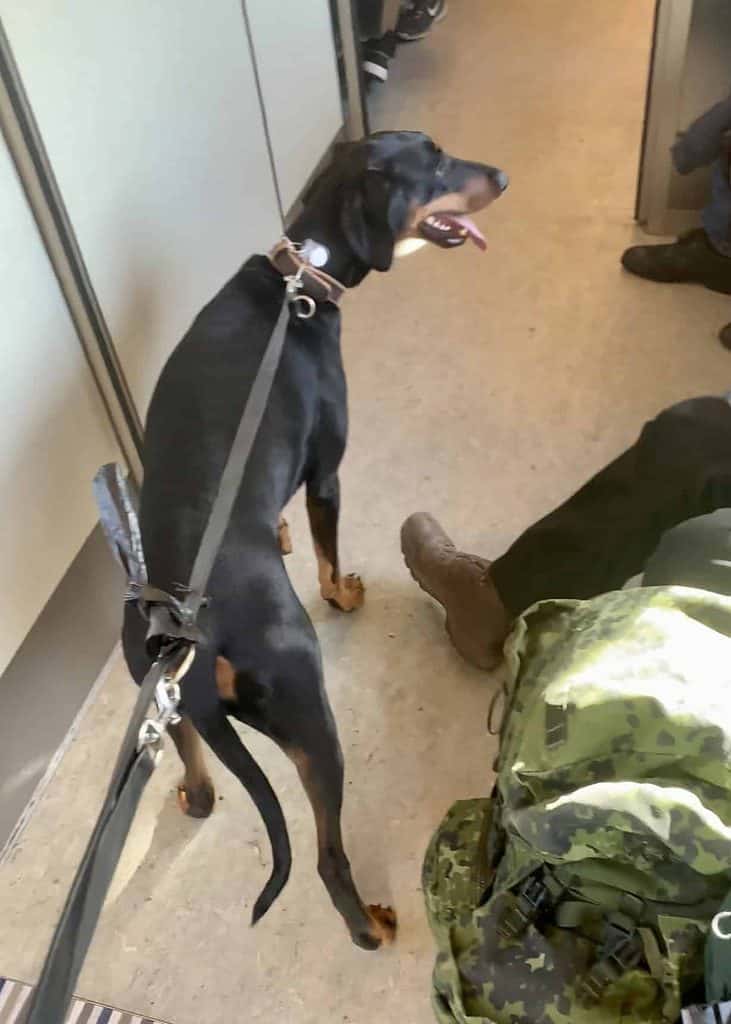My best four-legged friend Kira and I have both been traveling together and separated at times when I couldn’t bring her.
I guess you’ve already thought about the idea of letting your dog check in with family or friends, but the opportunity just isn’t there.
Whether it’s due to the lack of options, timing, or the trip you want to go on is too long to make it appropriate to ask for.
The good thing is it’s never been easier to travel as a dog owner. My goal is to thoughtfully present all the options you have, so you can ultimately decide what’s best for you and your dog.

📖 Table of Contents
1. Let Your Dog Stay at Home With a Trusted Housesitter
It’s not a coincidence I’ve given this option the #1 spot.
With Trusted Housesitters you can find verified and trusted housesitters to voluntarily take care of your dog and other pets in the comfort of your home.
The volunteers do this because they love spending time with animals. And in exchange for caring for your pet, they get free accommodation while traveling and exploring new places.
First of all, this allows your dog to stay in its familiar environment. But you also get access to unlimited care and other extras providing peace of mind with their membership ($129-259 a year).
Trusted Housesitters Standard Membership of $199/Year Includes:
- 🏡 Their Home & Contents protection if you already have existing home insurance. This gives you coverage of up to $1 Mio. As long as it’s arranged through their website.
This solves the problem with some home insurance policies that won’t cover if you’re leaving your home in the hands of others. - 💵 A money-back guarantee if you don’t receive an application within 14 days of posting your first listing.
- 📞 24/7 access to veterinary experts by phone, chat, and video for you and your sitter during your trip.

This also gives you a chance of having family, friends, or neighbors pass by if any assistance should be needed, or if you just feel like someone checking in to make sure everything is in order.
With the unlimited care included in their membership, you also get the flexibility of finding a sitter for shorter periods of days, even when you’re not necessarily traveling.
Judging by their many positive reviews and over +120.000 members, their 10 years in business is not a surprise.
You can visit their website here where you can also download their app 📲
Pros & Cons of Using a Trusted Housesitter
✅ Your dog gets to stay in its familiar environment
✅ It’s the most affordable option – especially for longer trips
✅ You can arrange to have your sitter take care of your plants too
✅ Having someone taking care of your home decreases the risk of burglary
❌ You’re not 100% guaranteed to find a sitter (but creating your listing in good time will increase your chances)
❌ You have to invest a little bit of time in creating a profile

2. Leave Your Dog in the Company of a Professional Facility
Now let’s discuss some of the more conventional options.
Chances are you’re already familiar with some of them, but maybe there’s one or more you haven’t thought of.
Though their purpose in many ways is more or less the same, they’re still very different from each other.
Examples of facilities:
- Boarding facilities
- Kennels (not recommended)*
- Pet hotels
- Professional pet sitters
- Vets (if your dog has any health issues)
*NB: There's an obvious reason I don't recommend kennels. Dogs often spend most of their time in smaller cages here which can have profound negative effects on their well-being.
If you decide to proceed with any of them, remember that there are several factors determining which option is best for your dog. Such as personality, age, and health.
It’s also common that your dog needs to undergo a short evaluation and sometimes stay for a day beforehand. This is to help it adapt to the new environment, ensure it has the fitting social skills, and isn’t too affected by separation anxiety.
And while the rules for each place are different, there are often some requirements.
Examples of common requirements:
- Being licensed with the city you reside in
- Meet a minimum age
- Have received common vaccines
- Being treated with parasite prevention/flea medicine
These requirements are set in place to protect you, your dog, and the other dogs at a facility.

How To Find Places Near You
- Use your network and ask friends, family, or colleagues, or consider making a post on social media
- Contact your vet or local charity for recommendations
- Use Google Maps to search for nearby places. Simply type in “boarding facility”, “pet hotel”, “pet sitter” or “vet”
How To Pick the Right Facility for Your Dog + Other Tips
While the facilities and prices often go hand in hand, there are some common things you should do to make sure you’re accommodating your dog at the right place.
- Lookup reviews online about the different places you’ve found
- Visit one or more facilities with your dog unannounced during opening hours, and check out the facilities and see how your dog reacts to it
- Get a feeling of the staff and whether they’re present and seem caring about you and the other dogs. This includes time for you to ask questions
- Make sure it’s not too cramped and there’s enough space for your dog to withdraw a bit in need of some privacy
- Notice if it looks and smells clean, and there’s no disproportionate amount of dog waste laying around
- Ensure that common vaccinations and medicine treatment against parasite prevention/flea are required
- Ask about the daily schedules to make sure there’s time for social interaction and play with other dogs, mental stimulation, and physical exercise
- Make sure there’s emergency veterinary care available and a plan in case of fires or natural disasters if your area is at risk
- Provide trusted family members or friends as emergency contacts if any situation should occur
- Ask whether it’s allowed to bring familiar toys or items such as blankets for your dog’s comfort.
📌 TIP: Though many negative reviews are genuine, it's often a good idea to keep a skeptical mind when researching a place. The reason is that some people are primarily motivated to leave a review after a bad experience. This often leaves good experiences out of the equation, which can lead to a false impression about a certain place. A good way to get around this is by checking whether a person has a natural balance between positive and negative reviews on a given website or platform.

Pros & Cons of Using a Professional Facility
✅ Your dog gets to socialize with other dogs
✅ A new place also means new areas for your dog to explore
✅ It’s often the only option if you have a shortage of time
❌ It can be stressful for your dog to go away and adapt to a new environment
❌ It’s the most expensive option
3. Bring Your Dog With You
This brings us to the last option.
While this depends on your destination(s) and type of travel. It also highly relies on your dog’s personality and health.
And though this requires a bit of work and limits your options when it comes to transportation and accommodation, it can be an enriching experience for you and your dog while creating good memories on the way.
If you have already decided on the destination(s) you’re going, the first thing you should do is check all the requirements of traveling to a specific country.
Luckily there’s a great and affordable service for this from Pettravelstore.com.
Their $22.5 pet passport includes:
- The right passport for your dog meets the specific requirements of each country
- Detailed and completed step-by-step instructions on completing forms and meeting the requirements of the country of your destination
- Provide you with the health certificate required for the specific country of your destination. Along with the health certificate required for most airlines
- Including forms such as declaration forms, permits, certificates, and quarantine procedures that may be required
- Unlimited e-mail support.
With the low price, it might even be worth it to use their service solely for research purposes.
Their information is guaranteed to always be up-to-date, and they’ve run their service for over 14 years.

Besides filling out forms and waiting for approvals, you might also need certain vaccinations, a microchip, and sometimes even quarantine upon arrival.
It’s important to keep this in mind so you can arrange everything in time, and decide whether you want to travel to a certain country that requires quarantine.
While not all countries require this, I wouldn’t personally feel comfortable letting my dog quarantine in a foreign land.
Transportation Options for Traveling With a Dog
Airplane
If your dog is too big to be allowed in a bag with you, they’ll get to stay in the undercarriage of the plane.
Here you’ll have the same air pressure and temperature as the passenger areas. And sometimes their crate is larger than any first-class seats.
So it’s not as bad as it sounds. But like everything else, it relies on your dog’s personality and health.
If your dog is too big to bring with you as a carry-on (as weird as it may sound) it needs to stay in a crate. And if that’s the case it’s a good idea to do some crate training beforehand.
By doing so you get to see how your dog reacts to it, and whether you’re able to make it comfortable through practice.
And it’s always a good idea to bring some familiar toys, blankets, or even dirty laundry for the crate to create a familiar environment while it’s on its own.
📌 TIP: Make sure you get written permission to bring your dog by the airline. This will prevent any complications and misunderstandings at the airport where time can easily be scarce.
Train
While this might sound like a straightforward option, your dog might not agree with you.
I once took Kira for a shorter train ride. She was quite anxious even before entering the train, and during the ride, she didn’t seem to settle at any time.
I’m sure she’d still prefer to go despite it. First of all the rides we take are shorter ones, and we always do so to go on hikes which is her absolute favorite thing to do.
But if your dog is like Kira and gets anxious about it, then going on longer journeys might be challenging for both of you.
If you’re considering this option I suggest starting with a smaller ride close to your home. This way you’d get to see how your dog reacts before committing to it.

Driving
Chances are you’re already familiar with this option.
But if you intend on driving there are still some things worth keeping in mind on longer journeys and the sometimes changing weather at new destinations.
It can easily be forgotten that we humans are used to sitting down for hours, but for dogs, it can be a challenge.
Here are my main tips for driving with your dog for longer distances:
- The first thing is to make sure you’re having a proper seatbelt installed for your dog. This is for everyone’s safety ✅
- The next thing is to schedule frequent stops, where there’s time for a walk and a break from driving. Kira isn’t a big fan of driving either, so whenever we do so it’s to relieve some stress for her too
- If it’s hot outside, make sure to crank up the AC, let in some fresh air, and provide enough water at each break.
Despite Kira’s sensitive nature, we’ve successfully driven a multiple-day 1000-mile trip from Denmark to Italy during a heat wave.
With that said she’s been frequently driving since she was a puppy, so it’s familiar to her.
But if your dog isn’t familiar with driving, It’s a good idea to go on some shorter trips first before committing to a longer trip.
This way you’d get to see how she/he reacts and provide a chance to train in suitable steps.
📌 TIP: While we might not think much about it, not all vehicles are equal. I once took Kira with me on a bus. But to my surprise, it was the most anxious I've ever seen her. This resulted in us getting off at the first stop and catching an alternative route by train, where we had to wait an hour and reached our destination much later.
Make Sure Your Dog Gets Some Exercise Before Departure
No matter what choice of transportation you choose, a good idea is to get some exercise beforehand.
This will help your dog relax during the journey. But consider joining, it’s been one of my rituals for a long time, and makes sitting for hours much more comfortable.
You might come across the option of using sedatives for your dog, but I don’t suggest this, except if it’s recommended as the last option by a professional. Since you can never be assured about potential side effects.
Alternatives to medication are often the best option. Where proper training and exercise will more likely help your dog overcome any challenges rather than postponing them.

Pros & Cons of Traveling With Your Dog
✅ You get to spend more time together and create good memories
✅ Your dog will join the adventure of exploring new places too
✅ It’s a good way to connect with new people on your travels, especially other dog owners
✅ Their need for daily walks will also help you explore new places
❌ Your choices of transportation and accommodation highly decrease.
❌ You’ll have to pack and carry more baggage
❌ It will increase your total traveling costs
❌ It can require a bit of work
📌 TIP: Check whether your destination is known for its population of stray dogs. Due to their unpredictable nature, this could result in undesirable encounters.
📍 Buy a GPS Tracker for Your Dog
No matter the option you choose, you can add an extra layer of safety by buying a GPS tracker for your dog.
Not only for when you’re traveling but also during everyday life at home.
By doing so you’ll always be ensured of its location, and be able to track it down in the unfortunate event of he/she should get lost.






Leave a reply